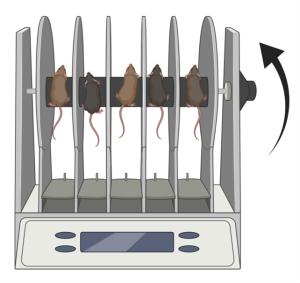Patients with ataxia share many common symptoms, including a loss of coordination. While these symptoms might be easy to see in patients, testing movement ability is not as straightforward in mouse models of ataxia. Because of this, researchers use something called the “rotarod performance test” to assess motor coordination and performance in mice.

What is a Rotarod?
A rotarod is a machine that is similar to a treadmill. It consists of a rod that rotates at a set speed and accelerates for a designated amount of time. During testing, mice are placed on the rod. The spinning of the rod causes the mice to jog. Researchers record the amount of time the mouse spends on the rod.

If a mouse spends less time on the rotarod, it suggests that the mouse has motor coordination deficits that are similar to an ataxia patient’s. Researchers also use the rotarod to assess motor learning in mice: the test is performed over multiple days. This is so they can determine how much motor learning has occurred by comparing how the mice did on the first day versus the last day.
Why do researchers use the Rotarod?
The rotarod allows researchers to measure the coordination and motor learning ability of mice. Having a consistent system of measurement also allows scientists to compare the results of different mouse models. For example, we can see how a new mouse model of ataxia performs compared to mice without ataxia. This allows us to see how severe the motor symptoms are in that specific model. This gives us the ability to confirm that the new mouse strain really does model ataxia.
More excitingly, though, we can use the rotarod to see what effect different treatments have on ataxia symptoms. If a treated mouse is able to spend more time on the rotarod than an untreated mouse, it suggests that the treatment helps improve motor symptoms. Seeing treatment results in a mouse model of ataxia gives researchers more confidence that the same treatment could be useful for patients with ataxia.
If you would like to learn more about the rotarod test, take a look at this video by the Maze Engineers.
Snapshot written by Eder Xhako and edited by Carrie Sheeler.










